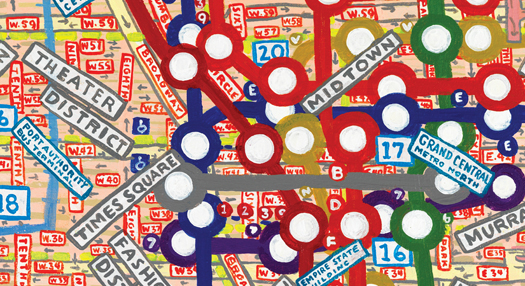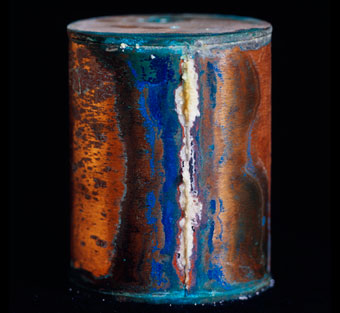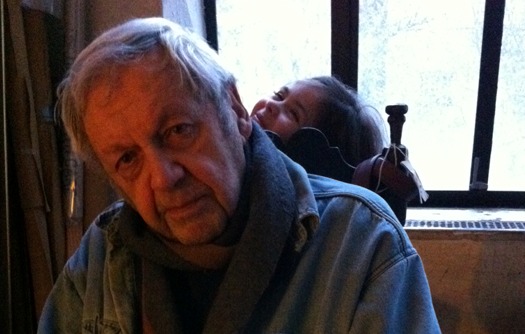
July 3, 2007
One Man’s Literary Compass
When I look at my bookshelves, I see my life. Whole glimpses of previous interests are represented, from my collection of Latin American fiction to the many reminders of the years I spent living in Italy (the novels of Primo Levi and Italo Calvino). There is my love of Ian McEwen, Susan Sontag and Paul Auster (which brings back memories of long-ago Saturday mornings spent in the New York Public Library researching and writing his bibliography). There are books about volcanoes and periodic tables; film books and architecture books. There are volumes from Paul Rand’s library and the works of Imre Reiner; and entire shelves filled with journals, including an almost complete run of Typographica. (If anyone has a copy, I’m only missing No. 4 from the First Series.) There is my extensive collection German literature — which has led to three books we’ve designed and published (Franz Kafka, Thomas Bernhard and Hans Erich Nossack), as well as a sentimental collection of beautiful English bindings that previously belonged to Jessica’s mother, Audrey Helfand.
Prized among these are many books by Jack Stauffacher — the legendary San Francisco designer and printer. So it is perhaps not surprising that when the photographer Dennis Letbetter sent me these 60 images of Stauffacher’s bookshelves, I immediately wanted to compare notes. I quickly spotted his complete run of The Journal of Typographic Research. And more: Loeb Classics, Italo Calvino, Stop Stealing Sheep, Hermann Zapf, Horace, Goethe, James Agee, African Socialism. There are books I also own, and others I only dream of owning. It is like my library, only so much better, and I instantly recognized these books for what they are: a touchstone of someone else’s life. “Without this working library,” notes Stauffacher, “I would have no compass, no map, to guide me through the density of our human condition.” I can not think of a more fitting description of a library, or one that so aptly describes a collector’s approach to the world.
When I asked about his library and these photographs, Jack Stauffacher wrote:
It was in 1966 when I returned to San Francisco to re-establish The Greenwood Press at the Independent Pressroom building at 300 Broadway on the 3rd floor. The first thing I did was to build bookshelves with my young architect friends, and at this time I brought with me a California wooden type cabinet of Baroque types cut by Nicholas Kis.
This cabinet of types have traveled to many places and when I closed my press in 1955 at 509 Sansome Street, San Francisco, I put them in storage; later, I brought them to Carnegie-Mellon University in 1958 and back to California in 1963 — these are the type-jewels and soul of The Greenwood Press.
These photographs by Dennis Letbetter, forty years later, capture so beautifully the soul and spirit of Greenwood. Without this working library, I would have no compass, no map, to guide me through the density of our human condition.
I have seen many great rare book libraries, especially among members of The Grolier Club. But the libraries I most enjoy are working libraries, where the books have been used and cited and annotated — first editions marred with underlining, notes throughout their pages. (I will always remember the chaos of Susan Sontag’s library, where every book had been touched, read and filled with notes and ephemera.) The organization of a working library is seldom alphabetical (or by color), but rather follows some particular mental construct of its owner. Jack Stauffacher’s shelves have some order, one knows. But it is his order, his life. The rest of us can only wonder — and perhaps feel covetous of a slim volume here and there.
Jack Stauffacher’s biography and citation for the AIGA Medal. More photographs of Jack Stauffacher’s Greenwood Press. And the work of photographer Dennis Letbetter is here.
An exhibition of collaborations between Jack Stauffacher and Dennis Letbetter, “The Vico Collaborations: 1972 | 2003 | 2006,” opens today through October 14 at Stanford University, Palo Alto, California.
Observed
View all
Observed
By William Drenttel
Recent Posts
A quieter place: Sound designer Eddie Gandelman on composing a future that allows us to hear ourselves think It’s Not Easy Bein’ Green: ‘Wicked’ spells for struggle and solidarity Making Space: Jon M. Chu on Designing Your Own Path Runway modeler: Airport architect Sameedha Mahajan on sending ever-more people skyward



